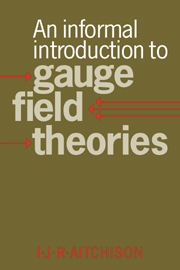Book contents
- Frontmatter
- Contents
- Preface
- Preface to the Paperback Edition
- 1 Introduction and motivations
- 2 Symmetries in quantum field theory: I Manifest
- 3 Gauge fields and the gauge principle
- 4 Quantisation of vector fields: I Massless
- 5 Quantisation of vector fields: II Massive
- 6 Symmetry in quantum field theory: II Hidden
- 7 Theory of weak and electromagnetic interactions
- 8 Renormalisation matters
- References
- Index
7 - Theory of weak and electromagnetic interactions
Published online by Cambridge University Press: 20 January 2010
- Frontmatter
- Contents
- Preface
- Preface to the Paperback Edition
- 1 Introduction and motivations
- 2 Symmetries in quantum field theory: I Manifest
- 3 Gauge fields and the gauge principle
- 4 Quantisation of vector fields: I Massless
- 5 Quantisation of vector fields: II Massive
- 6 Symmetry in quantum field theory: II Hidden
- 7 Theory of weak and electromagnetic interactions
- 8 Renormalisation matters
- References
- Index
Summary
Introduction
In 1960, Glashow, pursuing the goal of unifying the electromagnetic and weak interactions, proposed a ‘partially symmetric’ unified (electroweak) theory. By a ‘partial symmetry’ he meant one which was broken only by explicit mass terms in the Lagrangian (as in PCAC, discussed in Section 6.8). Considering the then-known charged weak currents, and of course the electromagnetic current, the natural candidate for a unified theory would be one involving three vector bosons, as in Section 5.2 above – the W±, and the γ. It was clearly realised, though, that Mw could not be zero, a fact which, to quote Glashow (1961), constituted ‘the principal stumbling block in any pursuit of the analogy between hypothetical vector mesons and photons’. Nevertheless, he went on: ‘It is a stumbling block we must overlook.’ One must marvel at such intuition, not to say faith. He went on to show that the simplest partially symmetric theory of the weak and electromagnetic interactions, in which the symmetry was violated only by explicit Mw terms in the Lagrangian, had to involve a neutral weak current, in addition to the charged ones then known. This implied the introduction of four bosons in all, the W±, the γ, and the neutral one Z0. In this scheme the symmetry group was precisely the SU(2) × U(1) of Sections 6.7 and 6.10. As a weak interaction symmetry, however, it applied to leptons (as well as to hadrons), and accordingly the leptons were to be classified according to representations of this ‘weak’ isospin and ‘weak’ hypercharge. Because Mw (and Mz) were so large, no visible residue of such a symmetry was likely to remain in the observed lepton spectrum.
Information
- Type
- Chapter
- Information
- An Informal Introduction to Gauge Field Theories , pp. 105 - 124Publisher: Cambridge University PressPrint publication year: 1982
